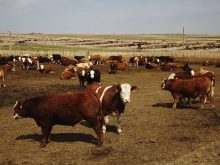RED DEER – When climatologist Art Douglas provides annual long-range
weather predictions to agricultural groups, he turns it into a teaching
session.
The lecturer from Creighton University in Omaha, Nebraska, guides his
listeners through the complex world of weather events.
From his analysis of global weather, he is predicting another growing
season of below-normal precipitation for southwestern Saskatchewan,
Alberta and Montana.
The west coast of British Columbia and northern regions of Western
Canada are likely to be wetter due to a developing El Nino, he said.
Read Also

Lending policy still focused on primary producers: Farm Credit Canada
Farm Credit Canada said it has not changed its business practices and remains committed to supporting all producers, after a report from an Ottawa-based media outlet claimed otherwise.
Manitoba and Ontario can also expect a wetter season.
“These are tendencies I expect to see with more frequency in the next
10 to 15 years,” he told the Alberta Cattle Feeders Association annual
meeting.
While most of the Prairies experienced a warmer, drier than normal
winter, spring weather is already on its way.
Temperatures are about 1.5 degrees Celsius below normal for this time
and he expects that to continue for the crop areas of the Prairies.
“It suggests a cool spring and late getting in there to work the soil.”
Forecasters like Douglas rely on a combination of methods to predict
the weather.
One strategy involves measuring daily sea temperatures.
Scientists can also monitor ocean movement and they know warmer water
is moving toward South America from Asia.
The Atlantic Ocean affects east coast weather while Pacific Ocean
activity affects western North America. Right now the Atlantic Ocean is
warmer than normal, which means more vigorous hurricanes on the east
coast.
However, shifting winds over the Pacific could weaken a developing El
Nino. Winds over the ocean change direction about every 12 months and
this influences weather in the western hemisphere.















